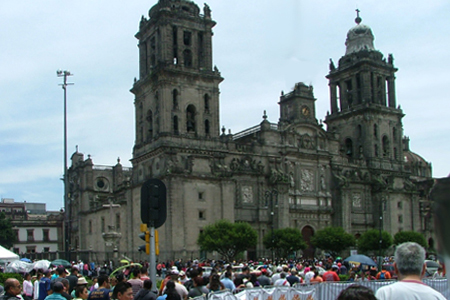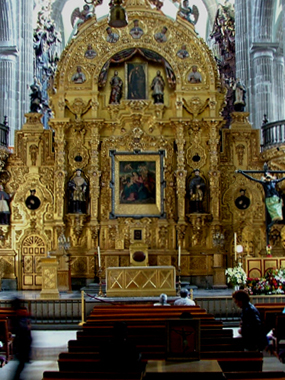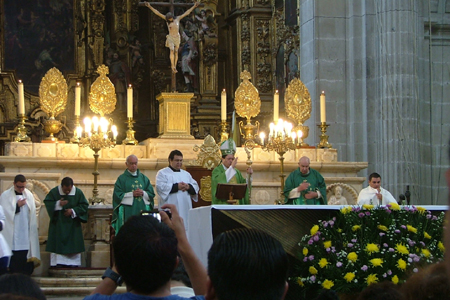| |
 |
 |
 |
| Comment on this report, or find other reports. |
 |
| Our Mystery Worshippers are volunteers who warm church pews for us around the world. If you'd like to become a Mystery Worshipper, start here. |
 |
| Find out how to reproduce this report in your church magazine or website. |
|
|
| 2568: Catedral
Metropolitana de la Asunción de María, Ciudad de México |
 |
 |
 |
Mystery
Worshipper: Amanda B. Reckondwythe.
The church:
Catedral Metropolitana de la Asunción de María, Ciudad de México.
Denomination:
Roman Catholic,
Archdiocese
of Mexico.
The building:
Begun in 1547 and finished in 1813, in a blend of baroque, neoclassic,
and Mexican churrigueresque architectural styles, the cathedral
is the oldest and largest church in Latin America. It is massive
– so much so that it has sunk several feet into the ground under
its enormous weight, a fact that one clearly notices as one
walks about the pavement outside the building. The east and
west bell towers hold rings of eighteen and seven bells, respectively.
In 1947, a bell ringer was killed when one of the bells struck
him in the head. The bell was "punished" by having
its clapper removed, and was known thereafter as la castigada
("the punished one"). Upon entering the cathedral, one is overwhelmed
by the elaborate décor of the five naves and sixteen chapels,
each with its own ornate altar, altarpiece, retablos, paintings,
furniture and sculptures that vie to outdo the others. There
are two principal altars in addition to the high altar: the
Altar of Forgiveness (Altar de Perdón) (first photo
below), at the front of the nave, before which persons condemned
by the Spanish Inquisition were brought to beg for divine mercy
before being executed; and the Altar of Kings (Altar de
los Reyes), behind the high altar, flanked by statues representing
canonized royalty (Edward the Confessor, Margaret of Scotland,
Helena of Constantinople, Elisabeth of Hungary, etc.).
The church:
According to the Archdiocese’s website, the cathedral seeks
to be "the leaven of Christian life among the residents
of the city, to help them live in communion with God and with
the men and women of our time." To that end, they offer
a variety of administrative, social, pastoral and evangelical
outreaches. One mass each Sunday is in Braille. The cathedral
is also active in the cultural life of the city, sponsoring
a full program of concerts and other artistic events. At the
opposite extreme of human affairs, the cathedral has over the
years been a venue for protests concerning a variety of social
issues. In 1926, in reaction to the Mexican government’s harsh
anticlerical policies of the time, Pope Pius XI ordered the
cathedral to be closed, not allowing it to reopen until 1930.
In more recent years, the cathedral bells were rung to protest
the Mexican Supreme Court’s finding in 2008 that the Constitution
included no legal impediment to abortion.
The neighborhood:
The cathedral dominates the Zócalo, Mexico City’s huge central
plaza, a popular gathering place all throughout the country’s
history. Its immediate neighbors are the National Palace, the
seat of the executive branch of the Mexican government; and
the Federal District Buildings, housing the government of Mexico
City. Off the Zócalo run several trendy side streets, some open
to pedestrians only, lined with chic boutiques and cafes.
The cast:
His Eminence Norberto Cardinal Rivera Carrera, Archbishop of
Mexico, and two unnamed concelebrating priests officiated at
mass. The Cardinal Archbishop was attended by two deacons and
two masters of ceremonies plus a retinue of four other priests
in full eucharistic vestiture; crucifer; acolytes; thurifer
and boat boy. All of the clergy were vested in green; the masters
of ceremonies in surplices and black cassocks (additionally,
one wore a vimpa); and the others in purple cassocks. Lay readers
wore dark grey suits, white shirts, and green ties (men) or
green scarves (women).
The date & time: Sixteenth Sunday in Ordinary Time, July 21, 2013, 12.00 noon.
What was the name of the service?
Misa (Mass).
How full was the building?
Packed to the rafters – standing room only.
Did anyone welcome you personally?
Sort of. The main nave is separated from the rest of the cathedral by a gated railing. An usher was stationed at the gate to separate out the tourists from the worshippers. He questioned only those who looked suspicious, including, alas, Miss Amanda, but he let me pass when I told him I was there for mass.
Was your pew comfortable?
I’ve sat in better plain wooden pews; I’ve sat in worse. Interestingly, the pews were not bolted to the floor.
How would you describe the pre-service
atmosphere?
When I arrived, a baptism service was in progress in one of the side chapels for well over 200 families who had brought their children to be baptized, some of whom had suffered under the pain of original sin for several years, judging from their apparent age. Tourists were reverently milling about the various aisles. An earlier mass was still in progress at the main altar, but a queue had formed at the gate. The usher let in whoever wanted to pass (and whoever passed his scrutiny) and we stood where we could find room. As that mass let out, the standees scrambled to find seats, and they quickly filled up. I was lucky enough to find a seat very close to the front, next to an impeccably dressed old Mexican lady (about whom more in a moment). A woman was mopping the floor in front of the Cardinal Archbishop’s throne. Everyone sat in silence. The organist played some Frescobaldi pieces. The cathedral bells were rung.
What were the exact opening words of the
service?
"En el nombre del Padre, y del Hijo, y del Espíritu
Santo." The entrance procession took all of 15 minutes
to traverse the center aisle, as the Cardinal Archbishop kept
stopping at various pews to shake the hand of anyone who proffered
one. The thurible billowed more smoke than a locomotive. The
organ was playing and all the cathedral bells were ringing –
all 25 of them (or 24, minus La Castigata). Pandemonium
– divine pandemonium! I was thrilled.
What books did the congregation use during the
service?
A handout containing the Gloria, Credo, intercessions, Lord’s Prayer, and all the readings for the day, all in Spanish.
What musical instruments were played?
The cathedral’s pipe organ, which sounded wonderful. There was a small choir – I don’t know how many, as I couldn’t see them. But the congregation sang lustily.
Did anything distract you?
The boat boy was the oldest boat boy I’ve ever seen – an elderly gentleman. Flash bulbs kept going off despite conspicuous large-lettered signs that read NO FLASH in English and Spanish. A lady next to me kept fanning herself with a hand fan. And, wouldn’t you know it,
someone’s cell phone went off right at the consecration.

Was the worship stiff-upper-lip, happy clappy, or
what?
Very stiff upper lip, but done with grace and dignity to perfection. Everyone knew their role and exactly how to carry it out. Incense billowed copiously, but alas, the cathedral is so vast that the smoke rose to the ceiling before it could waft out into the congregation. The cathedral bells were rung at the consecration. At communion time, the ushers carried white circular signs on tall poles with the letters IHS to the points at which eucharistic ministers would be stationed; we were instructed to line up at the sign closest to us. The Cardinal Archbishop was among those distributing communion, but when his ciborium was empty he returned to his throne to sit out the remainder of the ceremony. The little old Mexican lady and I were among those who received from his hand.
She remarked to me later how good it was to have had that experience when so many others couldn’t.
Exactly how long was the sermon?
10 minutes.
On a scale of 1-10, how good was the preacher?
8 – Cardinal Rivera preached from his throne using a prepared text that was subsequently posted on the archdiocese’s website. However, he looked up frequently from his text to ad-lib on his remarks.
In a nutshell, what was
the sermon about?
The Cardinal Archbishop preached on the day’s readings: Genesis
18:1-10 – Abraham shows hospitality to three visitors; Colossians
1:24-28 – God has commissioned Paul as a servant to spread his
Word; and Luke 10:38-42 – Mary and Martha entertain Jesus. Hospitality
is a virtue that distinguishes us from the rest of creation.
It isn't easy to practice hospitality in these modern times,
but God willing, we can always discover new ways to do so. We
are all guests in God's creation, traveling along the road to
our eternal home. If we open ourselves to practicing hospitality,
God will teach us new ways to do so, as Jesus taught Mary and
Martha. Jesus came not to be served, but to serve. There is
no prayer that speaks against hospitality. Yes, we should pray
that God's kingdom may come, but we should also pray that humility
and service may permeate all our activities. That is "the
better part."
Which part of the service
was like being in heaven?
The splendor of the cathedral and the priceless art treasures
it contains is indescribable. And the cathedral staff handle
the hordes of tourists so very well. I found almost the entire
experience to be heavenly.
And which part was like being in... er... the other place?
At communion time, everyone jostled and shoved their way through
the aisles to queue up behind the circular IHS signs – the otherwise
excellent cathedral staff need to devise a better way to handle
communion. And the music, while several levels above the “Singing
Nun Goes South of the Border” stuff you hear at Spanish masses
in the United States, was nevertheless somewhat disappointing.
There was plenty of time during the long entrance procession
for some Gregorian chant or Victoria motets, but alas, we didn’t
get any. According to the handout, they do have a schola cantorum,
but they sing only at the 9.00 mass each day.
What happened when you hung around after the service looking lost?
After Cardinal Rivera gave his final blessing, everyone broke
into applause. The Cardinal Archbishop kissed the altar, waved
good-bye, and sort of sauntered off the altar with the rest
of the altar party. There was no recessional. We all had to
exit quickly, as the crowd for the next mass was already jostling
for places as we had done for this mass. The little old Mexican
lady said "Hasta la vista" to me and dashed
off.

How would you describe the after-service
coffee?
There was none. I retired to a café on one of the side streets
off the Zócalo where I enjoyed a dish of huevos divorciados
– four fried eggs, two in red sauce and two in green sauce,
separated by a row of taco chips smothered in cheese. Very tasty.
How would you feel about making this church your regular (where 10 = ecstatic, 0 = terminal)?
10 – Hey, if I lived in Mexico City I’d be here every Sunday
for sure! I’d love to hear the schola cantorum.
Did the service make you feel glad to be a
Christian?
Yes! Yes! Yes!
What one thing will you remember about all this in seven days' time?
Quite a bit: the divine pandemonium of the bells, the incense
thick enough to fog in an airport, the altar choreography done
to perfection, the little old Mexican lady wishing me Hasta
la vista. |
|
|
 |
 |
 |
| We rely on voluntary donations to stay online. If you're a regular visitor to Ship of Fools, please consider supporting us. |
 |
 |
 |
| The Mystery Pilgrim |
 |
| One of our most seasoned reporters makes the Camino pilgrimage to Santiago de Compostela in Spain. Read here. |
 |
 |
 |
| London churches |
 |
| Read reports from 70 London churches, visited by a small army of Mystery Worshippers on one single Sunday. Read here. |
| |
|
|
|
|


